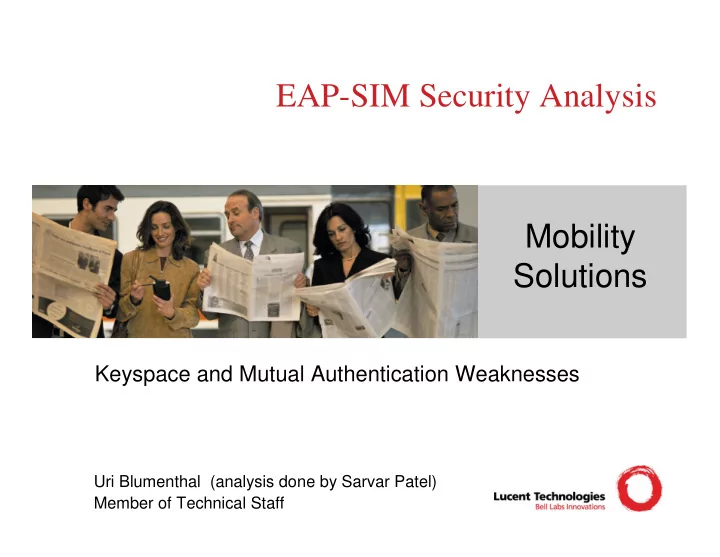

EAP-SIM Security Analysis Mobility Solutions Keyspace and Mutual Authentication Weaknesses Uri Blumenthal (analysis done by Sarvar Patel) Member of Technical Staff
EAP-SIM Draft and its Security Claims • Current EAP-SIM provides interoperability with GSM 2G cellular • Current EAP-SIM claims to provide 128-bit security – Two 64-bit attacks are described • Current EAP-SIM claims to be a Mutually Authenticated Protocol with Session Independence. – Session independence at the triplet level cannot be achieved 2
EAP-SIM Cryptographic Essentials Shared Root key K i GSM R c Client Authenticator <R 1 ,R 2 , R 3 >, MAC K [R 1 , R 2 , R 3 , R c ] GSM Triplets MAC K [SRES 1 ,…,SRES 3 ] MK K 3
Attack 1 – bring strength down to 64-bits • Impersonator chooses R and guesses corresponding K c – Probability of success 2 -64 not 2 -128 – Now attacker knows appropriate K c for the R • Impersonator sends <R R R> to the victim – Attacker makes all the triplets equal – Thus attacker knows K c for all R’s • Attacker creates Master Key MK and completes protocol • Solution 1: Enforce the check on R’s in the protocol – Client must ensure that all received R’s are different, or reject • Solution 2: Include SRES into key derivation input for MK – Gives 96-bit strength in total (even for one triplet) 4
Attack 2 - brute-force the 64-bit key • Condition: network uses N=1 and then moves to N=3 – Attacker observes the exchanges of single triplets – The network later switches to multiple triplets • Attacker brute-forces 3 keys of 64-bit when N=1 – Each Kc recovery requires 2 64 operations – Verification: compare responses – calculated with observed • Now attacker can impersonate the network for N=3 – Send <R 1 , R 2 , R 3 , MAC> to the victim (since Kc 1,2,3 are known) – Complete the protocol • Solution 1: never allow using single triplet • Solution 2: include SRES to key derivation input for MK 5
Lack of session independence • If Kc values for three triplets are compromised, then attacker can impersonate the network forever • Reason: Rc is not included in the Kc derivation – GSM specific: triplets are usually pre-computed by Network – GSM does not offer mutual authentication • Assumption “But Kc will never get exposed!” – If such were true, there would be no need to ever generate new triplets – Kc in GSM designed to be used for one session only! – Solution: none 6
Conclusions • Current EAP-SIM does not provide 128-bit security – Two successful 64-bit attacks were described – Solutions – minor improvements to the protocol (not currently incorporated) • Lack of session independence on triplet level – Can’t be practically solved 7
Recommend
More recommend